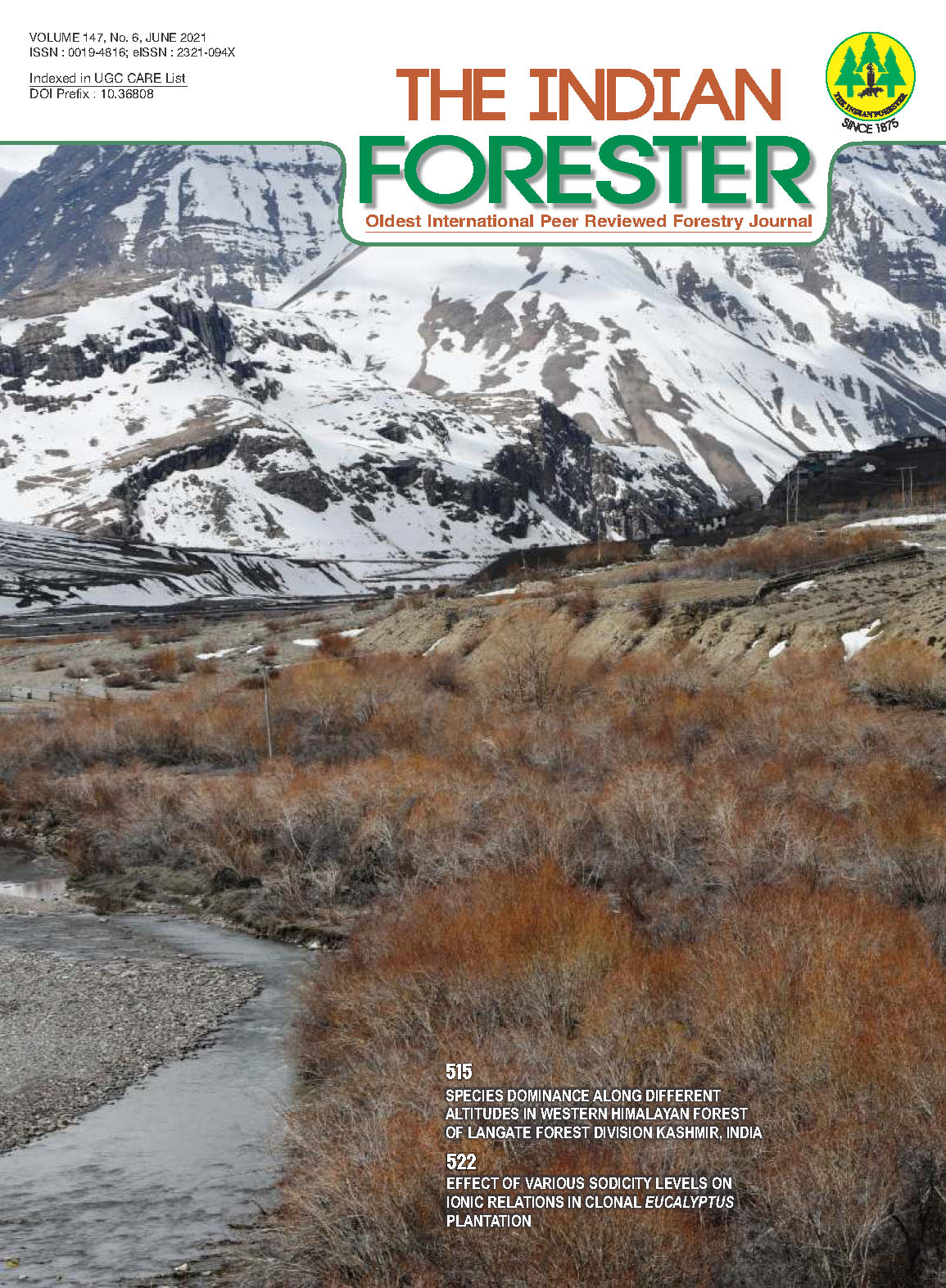Effect of Various Sodicity Levels on Ionic Relations in Clonal Eucalyptus plantation
DOI:
https://doi.org/10.36808/if/2021/v147i6/154696Keywords:
Clonal, Electrical Conductivity, Eucalyptus, Biochemical, Sodicity, Physiological, pH.Abstract
The present study aimed at understanding the effect of soil sodicity on physiological mechanisms and biochemical traits of Eucalyptus tereticornis clonal plantation under sodic soils with soil pH level ranging upto 10.0 and high Sodium Adsorption Ratio (SAR). Study was carried out in one and two year old Eucalyptus tereticornis field plantations. The results indicated increased proline content in plants growing under higher pH level. Plants growing on the soils of lower pH ranges (<8.2) recorded high chlorophyll content than trees growing under higher pH (>9.21) in first year (2.024ug/g FW) and second year old (1.931 ug/g FW) plantations. Sodium ions in the soil varied from 2.725 to 15.428 meq/L. Level of sodium ion uptake by leaves ranged between 0.12 to 0.13 per cent. The low sodium content in leaves favoured more uptake of potassium ions.References
Allen J.A., Chambers J.L. and Stine M. (1994). Prospects for increasing the salt tolerance of forest trees a review. Tree Physiol., 14: 843-53.
Anon. (2013). Annual Report, ICAR-Central Soil Salinity Research Institute, Karnal, India.
Ashraf M. and Ali Q. (2008). Relative membrane permeability and activities of some antioxidant enzymes as the key determinants of salt tolerance in canola (Brassica napus L.). Environmental and Experimental Botany, 63: 266-273.
Bassi P., Garg R.K., Choudhary O.P. and Kaur N. (2020). Effect of salinity stress on growth related physiological and biochemical traits of Casuarina clones in nursery. Indian Forester, 22(1): 90-96.
Bates L.S., Waldran R.P. and Teare I.D. (1973). Rapid determination of free proline for water stress studies. Plant Soil, 39: 205-208.
Bhatt, M.J., Patel, A.D., Bhatti, P.B. and Pandey, A.N. (2008). Effect of soil salinity on growth, water status and nutrient accumulation in seedlings of Ziziphus mauritiana. Journal of Fruit and Ornamental Plant Research, 16: 383-401.
Duncan D.B. (1955). Multiple range and multiple F tests.Biometrics, 11(1): 1-42.
Garg R.K., Yadav R.K., Sheoran P., Kumar A., Narjary B., Meena M.D. and Sharma D.K. (2017). Enhancing Productivity Potential of Saline Soil through Agroforestry System Using Saline Irrigation. Indian Forester, 143(9): 856861.
Hasegawa P.M., Bressan R.A., Zhu J.K. and Bohnert H.J. (2000). Plant cellular and molecular responses to high salinity. Annual Review of Plant Biology, 51(1): 463-499.
Hiscox J.D. and Israelstam G.F. (1979). A method for the extraction of chlorophyll from leaf tissue without maceration. Can J Bot 57: 1332-34.
Greenway H. and Munns R. (1980). Mechanisms of salt tolerance in nonhalophytes. Ann Rev Pl Physiol., 31(1): 14990.
Jackson M.L. (1973). Soil Chemical Analysis. Prentice Hall, New Delhi (India).
Marcar N.E., Crawford D., Ashwath N. and Thomson I.A.J. (1990). Salt and waterlogging tolerance of subtropical leguminous Australian native trees: A review. pp 375-387 in Naqvi SSM, Ansari R, Flowers TJ & Azmi AR(eds.) Intentional Conference on Current Developments in salinity and Drought Tolerance in Plants. AEARC, Tandojam, Pakistan.
Mudgal V., Madaan N., Mudgal A. and Mishra S. (2009). Changes in growth and metabolic profile of Chickpea under salt stress. Journal of Applied Biosciences 23: 1436-1446.
Najafi F., Khanvari-Nejad R.A. and Siah Al M. (2010). The effect of salt stress on certain physiological parameters in summer savory (Satureja hortensis) plant. Journal of Stress Physiology and Biochemistry, 6: 13-21.
Richards L.A. (1954). Diagnosis and improvement of saline and alkali soils. pp 7-33.
Soussi M., Lluch C. and Ocana A. (1999). Comparative study of nitrogen fixation and carbon metabolism in two chickpea cultivars under salt stress. Journal of Experimental Botany, 50: 1701-1708.
Downloads
Downloads
Published
How to Cite
Issue
Section
License
Unless otherwise stated, copyright or similar rights in all materials presented on the site, including graphical images, are owned by Indian Forester.





